No Fail Methods for Easy Peel Hard Boiled Eggs

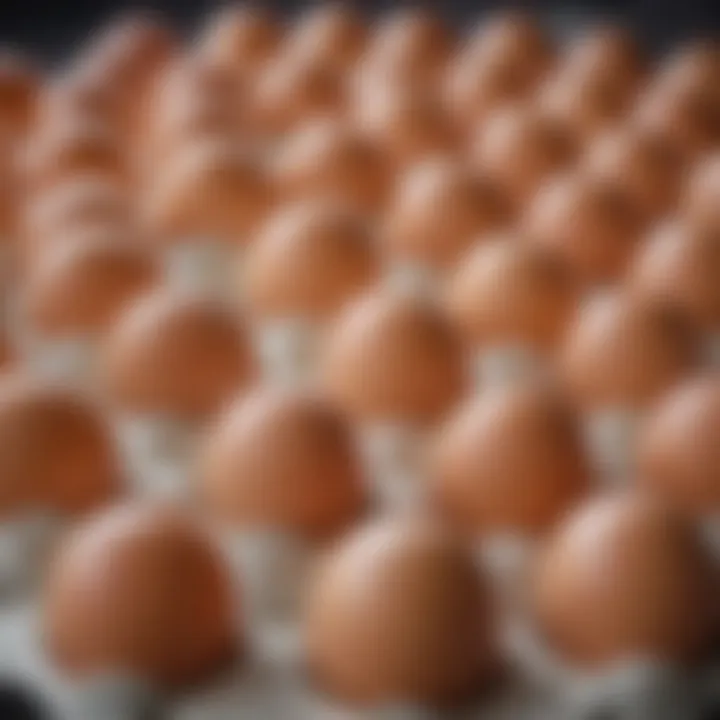
Intro
Hard boiled eggs are a beloved kitchen staple as they are versatile and packed with nutrients. However, many people face the common challenge of peeling them without losing half the egg white. This can create an irritating experience at meal prep or family gatherings. Fortunately, this guide covers foolproof methods for achieving easy-to-peel hard boiled eggs, designed for beginners and experienced cooks alike.
The focus here is on egg selection, cooking techniques, and cooling tips. By mastering these elements, anyone can eliminate irritation and transform their cooking experience. The sections that follow will give you a detailed look at not only how to boil eggs but also how to handle them efficiently post-boiling. Say goodbye to afternoon frustrations and hello to simple, satisfying results.
Recipe Highlight
Eggs at Their Best: Perfectly Hard Boiled Eggs
This recipe focuses on delivering hard boiled eggs that exit their shells smoothly, ready for salads or as a snack. Here are the main components to streamline your cooking:
- Essential Ingredients: Eggs, water.
- Estimated Time: Approximately 15 minutes for cooking, not including cooling.
- Servings: This recipe yields as many servings as desired, depending on the amount of eggs used.
Step-by-Step Instructions
Achieving successfully cooked and easy-to-peel hard boiled eggs involves a few clear steps:
- Choose Your Eggs: Older eggs typically peel better than fresh ones because their pH levels are higher, which aids in pulling away the membrane inside the shell.
- Boil the Water: Fill a pot with enough water to cover the eggs and bring it to a rolling boil.
- Add the Eggs: Once boiling, gently lower your eggs into the water using a slotted spoon. This minimizes cracking.
- Cooking Time: Set a timer for 9-12 minutes, depending on the desired yolk texture. For soft to semi-soft yolks, aim for 9 minutes. For firmer whites and yolks, leave them in for 12 minutes.
- Cooling the Eggs: Once the time is up, immediately transfer the eggs to an ice water bath. This halts the cooking quickly and assists with peeling later on.
- Peeling the Eggs: Once cool, tap the eggs lightly on a hard surface, rolling them gently to crack the shell. Peel under running water for best results.
Tip: Avoid excessive boiling as it can lead to darker rings around yolks, commonly caused by overcooked sulfur.
Common mistake to avoid: Do no skip the cooling process, as this can lead to stuck membranes.
Variations and Substitutions
While the recipe above hits the mark for classics, variations abound:
- Flavor Enhancements: Consider adding spices, such as chili powder or smoked paprika to the boiling water.
- Custom servings: Use these eggs in various dishes - salads, sandwich fillings, or blended to create deviled eggs.
Alternative Ingredients:
If you're sensitive to egg allergies, consider using tofu or chickpea variations, found in Asian cooking as a substitute.
Time-Saving Cooking Tips
Manusl prep and organization save important time during cooked operations:
- Prepare the water ahead. While waiting for it to boil, you can tidy your workspace or gather additional components.
- Share your time: Plan to cook specials in a batch. Batch cooking helps to ensure that you have prepared eggs for breakfasts, lunches, or snacks throughout the week.
Specific tools often hel to accelerate diligence; a reliable egg timer can streamline efforts; investing in an instant pot or egg cooker can ensure efficiency.
Nutritional Information
Each medium hard boiled egg is approximately 68 calories. Fundamental nutrients contained include:
- Protein: 6g per egg.
- Healthy Fats: 5g.
- Vitamins and Minerals: A range of essential nutrients, including Vitamins B12, D, and selenium.
These eggs can meld well with multiple diet plans, as they cater toward protein-focused diets such as keto and paleo.
Preface
Cooking perfect hard boiled eggs can often feel like a task fraught with challenges, especially when it comes to peeling them. Many cookrs encounter frustration when the egg shell does not cooperate, leaving them with unsightly bits of shell sticking stubbornly to the egg white. This article aims to tackle these obstacles head-on.
The importance of achieving a hard boiled egg that is easy to peel cannot be overstated. Hard boiled eggs are versatile additions to various dishes. From salads to breakfast plates, a well-peeled egg elevates the presentation and taste. Moreover, knowing how to prepare these eggs without hassle benefits all cooks, novices and experts alike.
Good techniques not only save time but also enhance your cooking confidences. Each step in selecting, cooking, and cooling eggs can contribute to a more enjoyable final product. Understanding these methods unlocks a smoother experience in the kitchen.
Understanding effective strategies will enable you to streamline your cooking process and delight others with beautifully presented dishes.
The Challenge of Peeling Hard Boiled Eggs
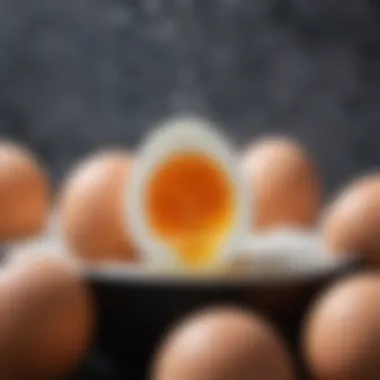
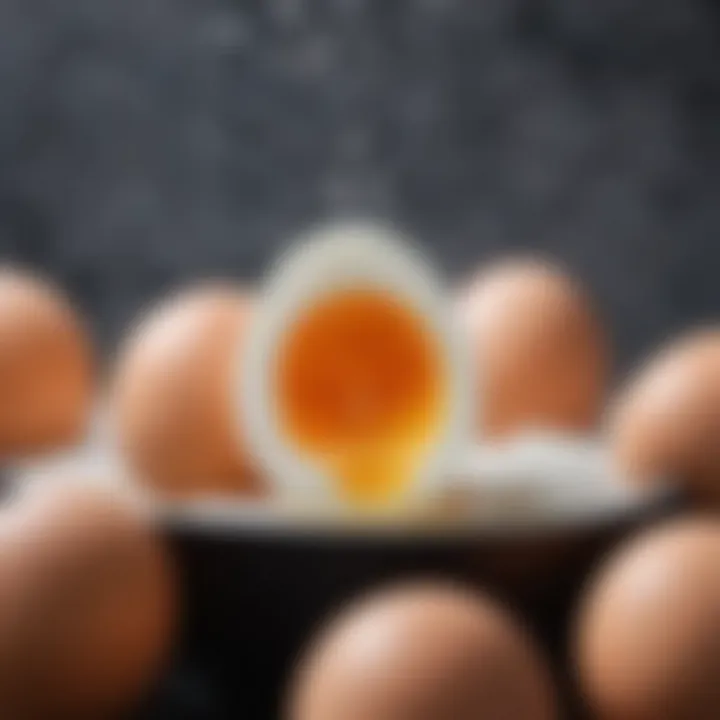
Peeling hard boiled eggs might seem simple, yet it poses a conundrum for many. The climactic moment when you strike the shell can either lead to victory or disaster. If eggs are too fresh, the membrane clings stubbornly to the egg white, creating irregular peelings. Conversely, using older eggs can yield better results but brings its own set of issues like fluctuation in taste and texture.
Apart from age, the cooking temperature affects how the egg white adheres to its shell's inner layer. This knowledge is crucial to eliminating peel challenges when boiling eggs.
Selecting the Right Eggs
Choosing the correct eggs is essential when aiming for hard boiled eggs that are easy to peel. Often overlooked, egg selection greatly affects the final result. Different factors impact cooking outcomes, including freshness and the method through which the chickens are raised. Understanding these nuances helps prevent frustration during peeling and ensures a more enjoyable egg-eating experience.
Egg shells can adhere to the egg white still tightly if the wrong type of egg is chosen. Whether you are a daily user of eggs or someone who cooks them occasionally, knowing how to select eggs is a fundamental part of successful cooking.
Fresh vs.
Older Eggs
The age of the eggs significantly influences ease of peeling. Fresh eggs have a different membrane structure in comparison to older eggs. When an egg ages, the pH level in the albumen increases, which helps the membrane separate more easily from the egg white. Older eggs produce much smoother peeling results thanks to this weakened bond.
- How to Identify Fresh Eggs:
- Examine the sell-by date on the carton.
- Perform the float test; fresh eggs will sink to the bottom, while older eggs stand upright or float.
Using slightly older eggs will yield better peeling results. If you want perfect hard boiled eggs, consider storing fresh eggs for at least a week before cooking them.
Free-Range vs.
Conventional Eggs
The method of raising hens impacts their eggs' quality and taste. Free-range hens usually enjoy better living conditions than conventionally-raised hens and often produce eggs with a richer taste and improved texture. These qualities can make a subtle difference in the final hard-boiled egg.
Comparing the Two Types:
- Free-Range Eggs:
- Conventional Eggs:
- Typically more flavorful.
- Higher quality; eggs usually have thicker shells, making them easier to peel.
- Usually less expensive.
- The overall egg experience may be less dynamic in taste or texture.
Choosing free-range might result in advantages not only in flavor but also in the cooking. Healthier hens seem to deliver better shells, which stand up to the boiling process more effectively.
Selecting the right eggs can drastically enhance your experience in achieving hard boiled eggs without the struggles of stubborn shells. Focus on older eggs and consider free-range when trying to increase both enjoyment and peeling success.
Preparation Techniques
Preparation techniques play a critical role in ensuring a good experience of cooking hard-boiled eggs that are easy to peel. These early steps affect not only the cooking quality but also the final presentation post-peeling. Utilizing proper preparation methods lays the essential foundation for the egg-cooking process, preventing problems such as overly tough whites and challenges in removing the shell.
Essential Tools Needed
Pot selection
When selecting a pot for boiling eggs, size and material are significant factors to consider. A larger pot can hold a greater number of eggs and ensures freedom of movement during boiling. Stainless steel is a popular choice for its durability and even heat distribution. This means the water temperature remains constant throughout, preventing uneven cooking.
A unique aspect of pot selection is the presence of a lid. A lid keeps the heat trapped, which can result in the waters easily reaching boiling point. This is an advantage in reducing cooking time and energy costs. However, those choosing a pot without a secure lid might find that water evaporates quickly, leading to inconsistent results during cooking.
Thermometer usage
Integrating a thermometer into your egg preparation adds an extra layer of control. A key feature of a thermometer is accuracy. It's particularly advisable to monitor water temperature rises when bringing water to a boil. This way, you can precisely track the cooking stages of the eggs.
Maintaining a specific water temperature is important to avoid rubbery and overcooked eggs. Thus, knowing when to start timing the boiling process ensures that your efforts lead to properly cooked eggs. However, using a thermometer might be seen as unnecessary due to the ease of boiling—though it can certainly enhance precision.
Initial Egg Treatment
Room temperature


Starting with eggs at room temperature can significantly enhance the boiling process. This simple yet effective method helps prevent cracking during cooking since any sudden temperature change can weaken the shell integrity. When the eggs are not too cold, they also cook more evenly.
A primary benefit to using room temperature eggs is enhanced cooking clarity. Even cooking is vital to avoid disastrous issues during the peeling phase afterward. Not warming them up could lead to increased peeling difficulties, perhaps leading to many frustrating moments.
Bringing eggs to temperature
Cooking Methods for Hard Boiled Eggs
Cooking methods for hard boiled eggs are central to achieving the desirable outcome of easy peeling. Understanding various cooking techniques allows you to tailor the method based on your kitchen equipment and personal preference. Whether you prefer the simplicity of stove boiling, the convenience of the Instant Pot, or the gentle touch of steaming, each method carries its own attributes that contribute significantly to egg preparation. Additionally, the method selected often impacts the overall texture and flavor, making it essential to choose wisely.
Stovetop Boiling Method
Water to egg ratio
Water to egg ratio plays a crucial role in the stovetop boiling method. Generally, using about 1 to 2 inches of water over the eggs ensures that they cook evenly. A proper water-to-egg ratio aids in maintaining consistent heat, allowing for optimal cooking conditions. This ratio is sought after due to its balance in ensuring all eggs heat uniformly.
One unique feature of this ratio is that it minimizes the risk of eggs breaking during boiling. However, too little water can lead to uneven cooking, resulting in some eggs being overcooked or undercooked. This method tends to be popular because it is straightforward and requires minimal equipment.
Boiling duration
Boiling duration is equally important in ensuring good hard-boiled eggs. Typically, 9 to 12 minutes is the general guideline for suitable results. This timing guarantees the whites are firm and the yolks reach a creamy consistency. By controlling boiling duration, one also affects the end product quality significantly.
A shorter boiling duration often results in soft yolks, while longer boiling can lead to the greenish shell that appears due to overcooking. Therefore, this temping approach offers a well-defined and sought-after timeline that cooks will find beneficial. The main disadvantage might be that it requires some precision in timing, needing careful monitoring.
Instant Pot Method
Settings and timing
In an Instant Pot, settings and timing represent the pinnacle of pressure cooking for eggs. Typically, using the manual or pressure cook setting for about 5 to 7 minutes ensures precision in cooking. This choice is beneficial due to how it leverages steam quickly, allowing the eggs to cook efficiently.
The most salient advantage lies in the set-it-and-forget-it approach, meaning you can use your time for other preparations. One key detail is that overcooking isn't as problematic when using a pot because it self-regulates temperature and pressure. Conversely, while using the Instant Pot may feel more complex, it ultimately results in perfectly cooked eggs with prominent flavor retention.
Pressure differences
Pressure differences constitute another intriguing aspect of cooking eggs in an Instant Pot. As the cooker applies a sealed pressure environment, it requires less time for the eggs to cook to your desired doneness. Restaurant chefs and busy homes alike benefit from this unique feature.
Cooking under high pressure results in less evaporation and retains moisture effectively. It stands as an advantageous choice, especially for anyone who feels pressed for time. The only drawback is the initial learning curve required to understand different pressure settings, which can be confusing for newcomers.
Steaming Method
Steam basket setup
The steam basket setup can be a practical yet effective concentrate of moisture and heat. Setting up a steam basket involves placing your eggs above boiling water in a pot. This method stands out for its gentle cooking technique that surrounds the eggs with improved ventilation.
It usually ensures consistent heat exposure throughout the cooking process. Moreover, this setup can be advantageous for novice cooks since it limits potential mishaps like cracking. A downside may include the necessity of having additional equipment, which not everybody possesses at home.
Steaming duration
Steaming duration is vital. Generally, steaming the eggs for about 12 to 14 minutes achieves perfect cooking results. Such timing captures the most optimal boiling effect without risking overcooking. Clearly defining this duration leads to gratifying outcomes, providing eggs that are both firm and flavorful, satisfying the appetites of all who indulge.
One primary advantage of this method includes its ability to escape excessive sulfur smells, which can occur with other approaches. Nevertheless, the disadvantage involves timing management as several pots may confer distracted operations and could result in some stress under preparations.
Cooling and Peeling Techniques
Cooling and peeling are crucial parts of demanding perfectly cooked hard boiled eggs. Proper cooling impacts the peeling process significantly. It promotes an easier and smoother removal of the shell. An efficient cooling technique will ultimately ease you frustration while ensuring that the egg whites remain intact. Knowing how and when to cool eggs can boost your success rate in achieving easily peeled eggs.
Immediate Cooling Steps
Using ice baths
Using ice baths is a well-known method to cool down hard boiled eggs quickly. This technique rapidly lowers the egg temperature. It causes the egg inside to slightly contract from the shell. This contraction plays an important role in preventing sticking between the shell and the egg. It proves beneficial for home cooks looking to simplify the peeling process.
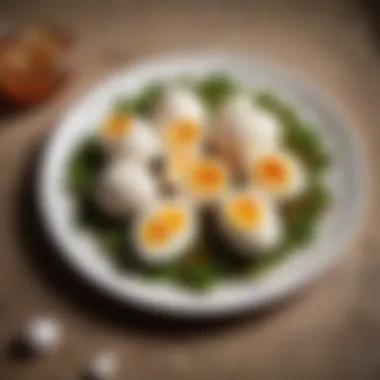
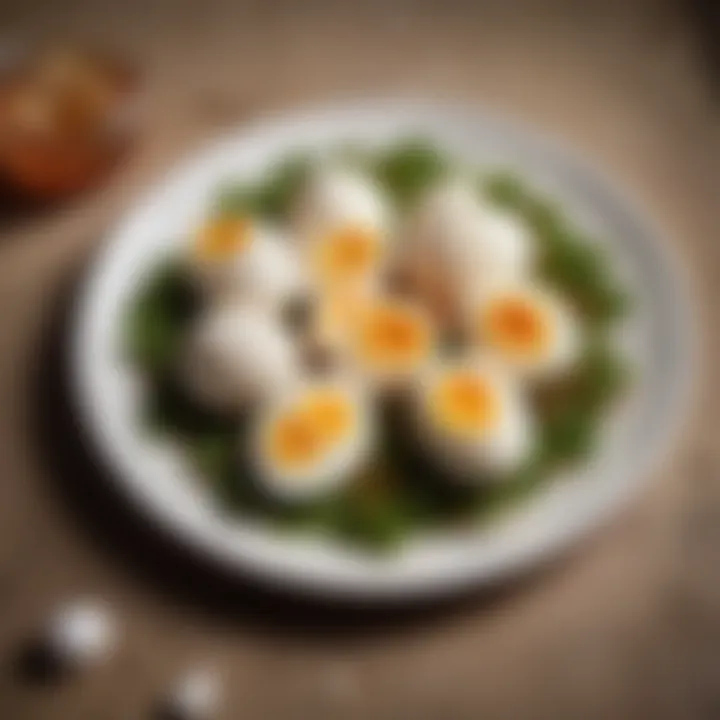
One of the key characteristics of an ice bath is its speed. Within just a few minutes, eggs cool down enough to be easily handled. A unique feature of ice baths is their ability to not just cool eggs but also to halt the cooking process immediately. While it brings advantages like heightened efficiency, one must ensure to prepare the ice bath ahead of boiling the eggs. This minimizes any downtime in the cooling process.
Cooling duration
Cooling duration turns out to be another important aspect in egg cooling methods. It determines how long the eggs need in the ice bath. Experts recommend a cooling duration of about 10 to 15 minutes. This period helps fully contract the membranes and eases shell removal. Generally, those who follow this guideline find higher peeling success rates.
To highlight its importance, a proper cooling duration helps maintain the integrity of the egg whites. Descended cooling can often lead to dark rings around the yolk, indicating overcooked eggs. This feature is frequently overlooked and can significantly affect aesthetics and flavour. Overlooking the cooling duration may lead to tough peeling experiences, making it a vital point to consider during the egg cooking process.
Peeling Strategies
Gently tapping method
The gently tapping method involves lightly tapping the boiled egg on a hard surface to crack the shell. This method focuses on creating small, controlled fractures throughout the shell. It seeks effective breaking allowing for a smoother transition during peeling. The benefit of the gently tapping method lies in its simplicity, making it accessible for all skill levels.
One main characteristic of this method stems from its adjustable pressure. It provides flexibility and can be adapted per the thickness of the egg's shell. However, a unique feature that it's guaranteed to leave the whites relatively untouched is intriguing. If done correctly, it serves as a key favorable point for egg enthusiasts who uniquely favour unblemished appearances in their cooking.
Rolling technique
The rolling technique involves rolling the egg gently under your palm against a flat surface. This method poses an alternative to the gently tapping technique. Its main purpose is also to create crack networks on the shell for effortless peeling. Rolling can be beneficial as it spreads pressure evenly across the entire egg's surface. It effectively creates a higher probability of smooth cellulose separation.
A notable characteristic of the rolling technique is how quick it allows peeling. Instead of focusing cracks on just a handful of spots, the entire shell receives joint pressure. However, some may find this sensation less handy if the eggs are too cool or if they have fragile shells. Despite little drawbacks, many housewives appreciate its swift results in shelling.
In summary, know that cooling and peeling techniques are essential for easily enjoying hard boiled eggs. Understanding the impact of cooling on peeling can make a world of difference.
Common Mistakes to Avoid
When it comes to perfecting the method of boiling eggs, avoiding common mistakes is crucial. Each phase in preparing hard boiled eggs can either make or break the final result. Understanding what's detrimental in the process equips you to enhance your culinary approach, ensuring easy peeling. Here are some grave errors to steer clear of:
Overcooking Eggs
Overcooking eggs is a prevalent mistake that many are guilty of. When eggs cook too long, two things can happen: a rubbery texture develops, and that indicates a distinct variance in quality. Moreover, a greenish hue may appear around the yolk, which is an unwanted aesthetic result often branded as unsophisticated cooking.
To avoid overcooking eggs, timing is critical. The correct time to boil needs to be followed critically, paying attention to the method you choose—whether stovetop boiling, the Instant Pot approach, or even steaming. Typically, a well-timed five to twelve-minute window based on your desired firmness minimizes the chances of overcooking.
Tips for managing cooking time include:
- Set a timer right away.
- Utilize a consistent source of heat.
Having reliable procedures is key to anyone looking to master hard boiled eggs. Learning expertise in timing helps build one's confidence amidst stove and Instant Pot clutter.
Skipping Cooling Steps
Another common mistake is neglecting the cooling stage post-cooking. Many people intuitively want to eliminate the eggs from heat and shelf them right away. However, cooling ensures that the eggs settle after boiling, inhibiting the residual cooking progression. This oversight can undermine the effort you put into making those eggs.
Cooling can be achieved effectively through options such as using an ice bath. This dramatically halts the cooking process, retaining egg quality. Additionally, ensuring proper cooling duration, which typically ranges from 5 to 10 minutes in a chilled environment, means you’ll benefit from easier peeling.
Important Cooling Practices:
- Fill a bowl with ice and water ahead of time.
- Transfer eggs immediately after boiling without delay.
Cooling stages should never feel like an afterthought. This phase is as vital as cooking, lending your eggs the mistress of time and space they need before conflict with shell begins.
By being mindful of these mistakes, you refine your method significantly. Acknowledging that it’s easy to compromise in either overcooking or rushing the cooling brings preparedness, ultimately yielding delicious, easy-to-peel hard boiled eggs.
Epilogue
In this article, we have delved into how to achieve hard boiled eggs that are simple to peel. The techniques discussed are crucial not only for a smoother cooking experience but also for an enhanced result. Properly selecting the right eggs, utilizing effective cooking methods, and understanding the cooling process sets a solid foundation for the peeling process. Each aspect influences the ease with which one can separate the shell from the egg, impacting both aesthetics and texture in a culinary dish.
Recap of Techniques
To summarize the essential techniques:
- Egg Selection: Choose older eggs if possible, as they tend to peel easier than fresh ones. The difference in pH affects the adherence of the shell to the egg white.
- Cooking Methods: Every method—whether it be stovetop boiling, Instant Pot, or steaming—has its own time frame and preparation steps for optimal results. The key can vary between the ratio of water tomatoes, pressure settings, or required steaming duration.
- Cooling Practices: Implementing an ice bath post-cooking halts the cooking process immediately. This is a critical step for easy peeling.
Encouragement to Experiment
As you embark on making hard boiled eggs, experiment with different techniques and toppings. Cooking is as much about methodologies as it is about personal touches. Test various cooling durations or select eggs from different sources. You may discover a mix that suits your palate.
Furthermore, don't hesitate to document your observations. Recording your preferred methods assists in refining the approach used in the kitchen for future efforts. Testing alters understanding and skill, creating a layering of expertise over time. Remember, mastery comes from practice—layering countless trials leads to confidence in result.







